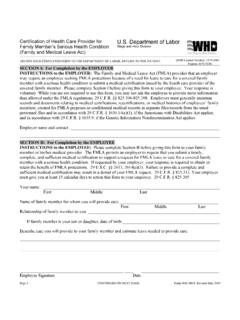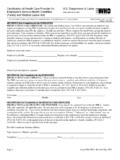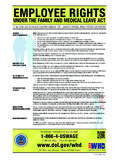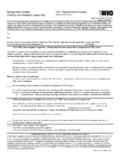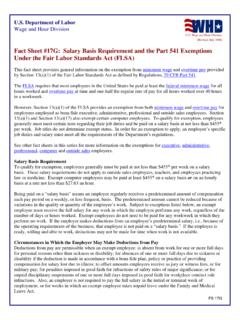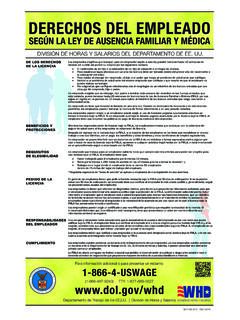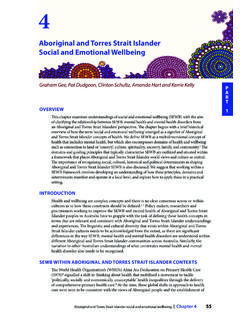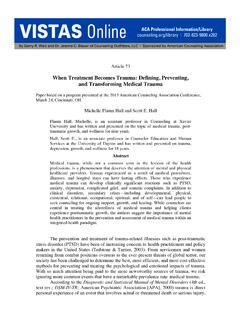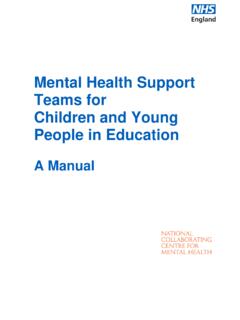Transcription of Disclosure Guide: Making the Most of Your Mental Health ...
1 CONSUMER GUIDE TO Disclosure RIGHTS: Making THE MOST OF. YOUR Mental Health AND substance USE DISORDER benefits . ACKNOWLEDGMENTS. This report was prepared for the substance Abuse and Mental Health Services Administration (SAMHSA), Department of Health and Human Services (HHS), in consultation with the Employee benefits Security Administration (EBSA), Department of Labor (DOL), by Truven Health Analytics, an IBM. Company, under SAMHSA IDIQ Prime Contract #HHSS283200700029I, Task Order #HHSS28342002T with SAMHSA, HHS. Mariel Lifshitz served as the Government Project Officer. DISCLAIMER. This document is not meant to be considered legal advice and is not representative of the official position of the Departments of Labor, Health and Human Services, and the Treasury. This document is intended to give a basic understanding of certain requirements related to MHPAEA and claims and appeals under the Public Health Service Act (PHSA), the Employee Retirement Income Security Act (ERISA), and the Internal Revenue Code (the Code).
2 The statute, recent regulations, and other guidance issued by the Departments should be consulted. SAMHSA complies with applicable Federal civil rights laws and does not discriminate on the basis of race, color, national origin, age, disability, or sex. SAMHSA. cumple con las leyes federales de derechos civiles aplicables y no discrimina por motivos de raza, color, nacionalidad, edad, discapacidad o sexo. PUBLIC DOMAIN NOTICE. All material appearing in this report is in the public domain and may be reproduced or copied without permission from SAMHSA and DOL. Citation of the source is appreciated. However, this publication may not be reproduced or distributed for a fee without the specific, written authorization of SAMHSA, HHS. and EBSA, DOL. ELECTRONIC ACCESS AND COPIES OF PUBLICATION. This publication may be downloaded on the substance Abuse and Mental Health Services Administration website at or the Department of Labor, Employee benefits Security Administration website at RECOMMENDED CITATION.
3 substance Abuse and Mental Health Services Administration. Consumer Guide to Disclosure Rights: Making the Most of your Mental Health and substance Use Disorder benefits . HHS Publication No. (SMA)16-4992, Rockville, MD: substance Abuse and Mental Health Services Administration; 2016. ORIGINATING OFFICES. Office of Policy, Planning, and Innovation, substance Abuse and Mental Health Services Administration, 5600 Fishers Lane, 18E85C, Rockville, MD 20852. Department of Labor, Employee benefits Security Administration, 200 Constitution Avenue, NW, Washington, DC 20210. HHS Publication: No. (SMA)16-4992. Department of Health and Human Services, substance Abuse and Mental Health Services Administration Department of Labor, Employee benefits Security Administration 2. CONSUMER GUIDE TO Disclosure RIGHTS: Making THE MOST OF YOUR Mental Health AND.
4 substance USE DISORDER benefits . One of the many important components of both the Affordable Care Act and the Mental Health Parity and Addiction Equity Act is to ensure that Health plans treat Mental Health and substance use disorders the same way that they treat other Health issues. The Mental Health Parity and Addiction Equity Act requires group Health plans and insurers that offer Mental Health and substance use disorder benefits to provide coverage that is comparable to their coverage for general medical and surgical (medical/surgical) care. Limitations on Mental Health and substance use disorder benefits (such as copayments, visit limits, and preauthorization requirements) must generally be comparable with those for medical/surgical The parity law, also known as the Mental Health Parity and Addiction Equity Act, and other laws require transparency and Disclosure of information.
5 This publication provides a general explanation of the various federal Disclosure lawsii affecting private-sector, employer- sponsored group Health plans and Health insurers. The following table provides information about important documents that may be available to you under various federal laws. This resource can help you better understand what information to request to help determine which Mental Health or substance use disorder benefits will be paid for by your Health plan, what information your plan relies on to approve or deny benefits , and what information is available to help you determine if your plan's Mental Health and substance use disorder benefits are offered at parity. In general, employees and former employees who are eligible to enroll in the plan or who may become eligible to enroll in the plan (referred to as participants ), their covered family members (referred to as beneficiaries ), and an authorized representative (such as an appropriately authorized family member or medical provider acting on behalf of a participant or beneficiary) are entitled to receive this information.
6 Under the Mental Health Parity and Addiction Equity Act and other Federal laws, you are entitled to many different documents related to your Mental Health and substance use disorder and medical/surgical benefits . These scenarios offer suggestions of certain documents you may want to request, but you have a legal right under the Mental Health Parity and Addiction Equity Act and other federal laws to request additional information, if you believe it will be helpful. While this document will assist you in understanding your rights to information that may be helpful, it is not a comprehensive description of these laws and should not be considered legal advice. For other types of coverage, such as individual market coverage, you should check with your state department of insurance for the most accurate information regarding your Disclosure rights.
7 Also, your state may have other laws that affect your behavioral Health coverage. The National Association of Insurance Commissioners at provides access to state websites with information on particular state Health insurance laws. Department of Health and Human Services, substance Abuse and Mental Health Services Administration Department of Labor, Employee benefits Security Administration 3. A glossary defining common Health plan and legal terms is included at the end of this publication. These terms and definitions are intended to help you understand this document and may be different from the terms and definitions used by your plan. Some of these terms also might not have exactly the same meaning when used in your policy or plan, and in that case, the policy or plan governs. Common scenarios that may affect your Mental Health and substance use disorder benefits **Important note: You may fit into more than one scenario at a time.
8 Review all the scenarios to see all the information that is relevant for you. WHERE TO START? SCENARIO WHEN CAN I GET THESE DOCUMENTS? SUGGESTIONS FOR INFORMATION YOU HAVE A RIGHT TO THAT CAN HELP. 1. I am thinking about A Summary of benefits and Coverage Summaries of benefits and changing Health Coverage are distributed with initial coverage and would The Summary of benefits and Coverage provides a brief description of enrollment materials and annually. like to understand the benefits and coverage under a plan, including coverage of Mental Health and They also must be provided upon benefits available substance use disorder benefits . The Summary of benefits and Coverage request, generally within seven under my coverage includes: business days. options (known as a benefits overview). 1. A description of the Health coverage (including cost sharing, such as If a plan makes a significant mid-year deductibles, co-insurance, and copays); coverage change that would affect the 2.
9 The exceptions or changes to the benefit plan, and limitations on contents of the Summary of benefits coverage; and and Coverage, it must send out a 3. Coverage examples. notice at least 60 days before the change takes effect. If you have more questions after reviewing your Summary of benefits and Coverage, request a Summary Plan Description, described below. Department of Health and Human Services, substance Abuse and Mental Health Services Administration Department of Labor, Employee benefits Security Administration 4. WHERE TO START? SCENARIO WHEN CAN I GET THESE DOCUMENTS? SUGGESTIONS FOR INFORMATION YOU HAVE A RIGHT TO THAT CAN HELP. 2. I am not sure what Summary Plan Description and any Summaries of Material Modifications. Summary Plan Descriptions are Mental Health and generally distributed within 90 days substance use disorder Summary Plan Descriptions are important Disclosure documents prepared by after the date a participant first treatments my plan will the plan that describe, in understandable terms, the rights, benefits , and becomes covered by the plan.
10 They pay for, or if there are responsibilities of participants and beneficiaries. The Summary Plan also must be provided upon written limits or exclusions on Description must include important information regarding the plan, such as request, generally within 30 days. these benefits . information on how the plan works, eligibility requirements, what benefits the plan provides, and how those benefits may be obtained, including how Summaries of Material Modifications the plan covers Mental Health and substance use disorder benefits . The that describe an important reduction plan's claims procedure, including applicable time frames, must also be in covered services or benefits must included in the Summary Plan Description, or in a separate document generally be provided automatically distributed with the Summary Plan Description.
